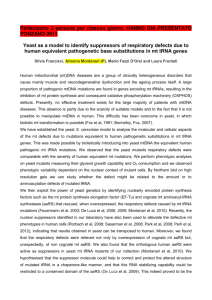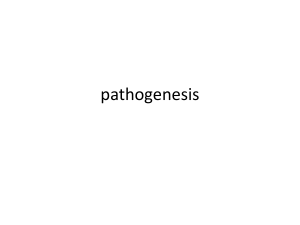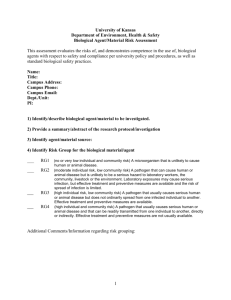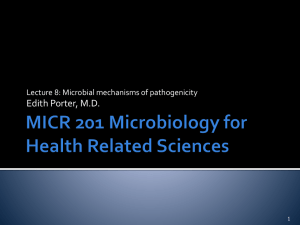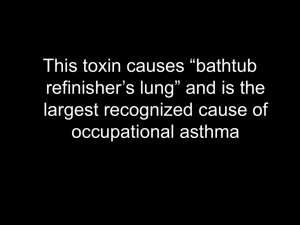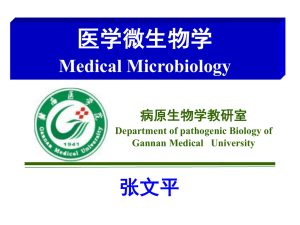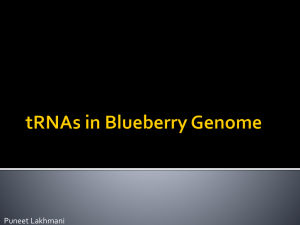Template for abstracts
advertisement
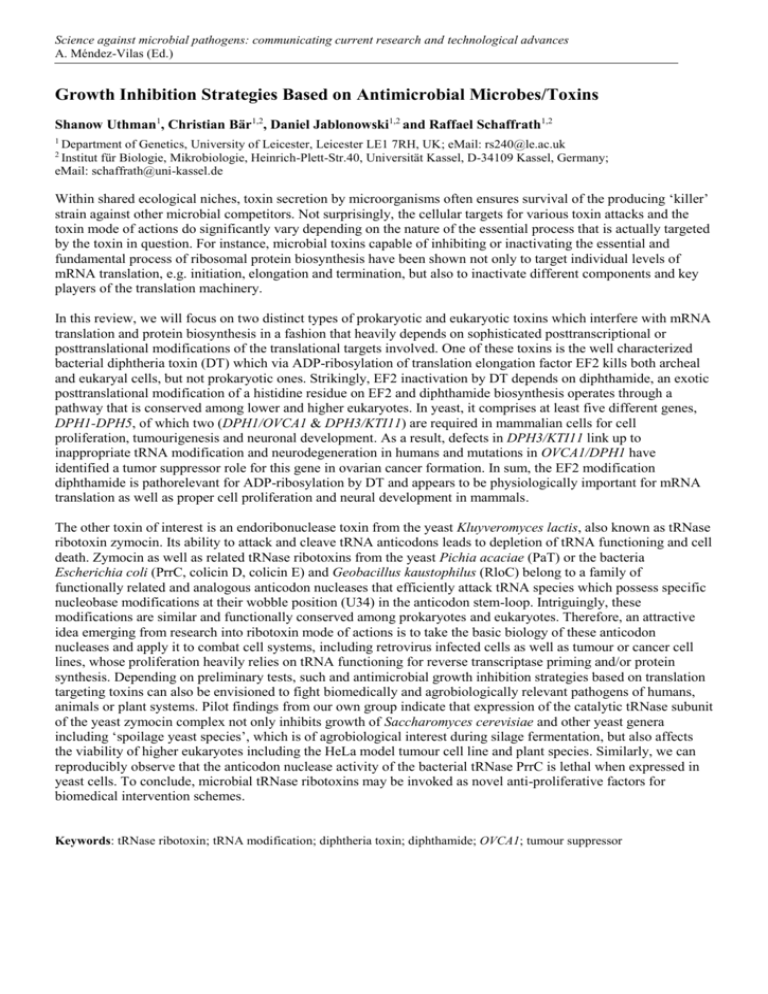
Science against microbial pathogens: communicating current research and technological advances A. Méndez-Vilas (Ed.) Growth Inhibition Strategies Based on Antimicrobial Microbes/Toxins Shanow Uthman1, Christian Bär1,2, Daniel Jablonowski1,2 and Raffael Schaffrath1,2 1 Department of Genetics, University of Leicester, Leicester LE1 7RH, UK; eMail: rs240@le.ac.uk Institut für Biologie, Mikrobiologie, Heinrich-Plett-Str.40, Universität Kassel, D-34109 Kassel, Germany; eMail: schaffrath@uni-kassel.de 2 Within shared ecological niches, toxin secretion by microorganisms often ensures survival of the producing ‘killer’ strain against other microbial competitors. Not surprisingly, the cellular targets for various toxin attacks and the toxin mode of actions do significantly vary depending on the nature of the essential process that is actually targeted by the toxin in question. For instance, microbial toxins capable of inhibiting or inactivating the essential and fundamental process of ribosomal protein biosynthesis have been shown not only to target individual levels of mRNA translation, e.g. initiation, elongation and termination, but also to inactivate different components and key players of the translation machinery. In this review, we will focus on two distinct types of prokaryotic and eukaryotic toxins which interfere with mRNA translation and protein biosynthesis in a fashion that heavily depends on sophisticated posttranscriptional or posttranslational modifications of the translational targets involved. One of these toxins is the well characterized bacterial diphtheria toxin (DT) which via ADP-ribosylation of translation elongation factor EF2 kills both archeal and eukaryal cells, but not prokaryotic ones. Strikingly, EF2 inactivation by DT depends on diphthamide, an exotic posttranslational modification of a histidine residue on EF2 and diphthamide biosynthesis operates through a pathway that is conserved among lower and higher eukaryotes. In yeast, it comprises at least five different genes, DPH1-DPH5, of which two (DPH1/OVCA1 & DPH3/KTI11) are required in mammalian cells for cell proliferation, tumourigenesis and neuronal development. As a result, defects in DPH3/KTI11 link up to inappropriate tRNA modification and neurodegeneration in humans and mutations in OVCA1/DPH1 have identified a tumor suppressor role for this gene in ovarian cancer formation. In sum, the EF2 modification diphthamide is pathorelevant for ADP-ribosylation by DT and appears to be physiologically important for mRNA translation as well as proper cell proliferation and neural development in mammals. The other toxin of interest is an endoribonuclease toxin from the yeast Kluyveromyces lactis, also known as tRNase ribotoxin zymocin. Its ability to attack and cleave tRNA anticodons leads to depletion of tRNA functioning and cell death. Zymocin as well as related tRNase ribotoxins from the yeast Pichia acaciae (PaT) or the bacteria Escherichia coli (PrrC, colicin D, colicin E) and Geobacillus kaustophilus (RloC) belong to a family of functionally related and analogous anticodon nucleases that efficiently attack tRNA species which possess specific nucleobase modifications at their wobble position (U34) in the anticodon stem-loop. Intriguingly, these modifications are similar and functionally conserved among prokaryotes and eukaryotes. Therefore, an attractive idea emerging from research into ribotoxin mode of actions is to take the basic biology of these anticodon nucleases and apply it to combat cell systems, including retrovirus infected cells as well as tumour or cancer cell lines, whose proliferation heavily relies on tRNA functioning for reverse transcriptase priming and/or protein synthesis. Depending on preliminary tests, such and antimicrobial growth inhibition strategies based on translation targeting toxins can also be envisioned to fight biomedically and agrobiologically relevant pathogens of humans, animals or plant systems. Pilot findings from our own group indicate that expression of the catalytic tRNase subunit of the yeast zymocin complex not only inhibits growth of Saccharomyces cerevisiae and other yeast genera including ‘spoilage yeast species’, which is of agrobiological interest during silage fermentation, but also affects the viability of higher eukaryotes including the HeLa model tumour cell line and plant species. Similarly, we can reproducibly observe that the anticodon nuclease activity of the bacterial tRNase PrrC is lethal when expressed in yeast cells. To conclude, microbial tRNase ribotoxins may be invoked as novel anti-proliferative factors for biomedical intervention schemes. Keywords: tRNase ribotoxin; tRNA modification; diphtheria toxin; diphthamide; OVCA1; tumour suppressor


